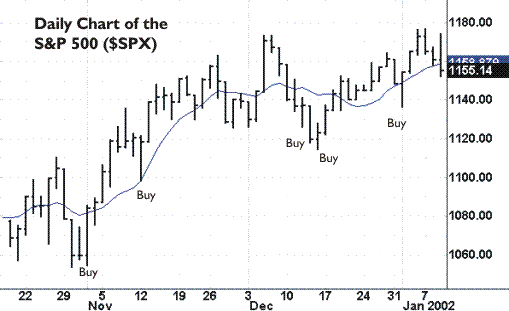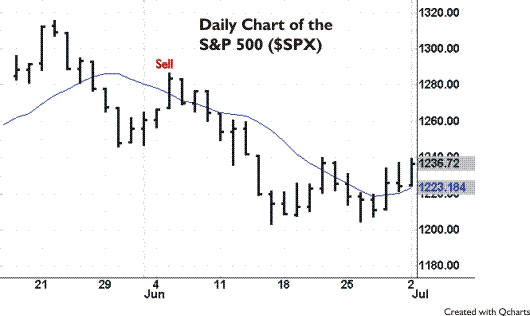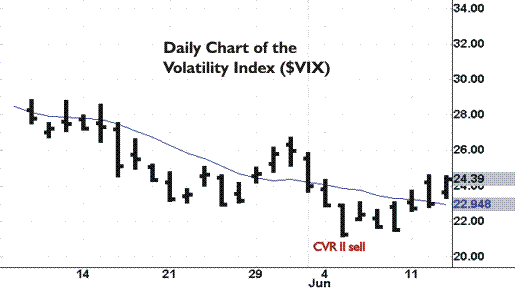Market Timing Using The VIX
The following was
transcribed and edited from TraderTalk, a free, live, interactive workshop
conducted for TradingMarkets members by Larry Connors.
What Is The VIX?
In my opinion, the VIX is the best
market-timing indicator available for short-term traders today. The VIX is,
simply, a measurement of the implied volatility of the at-the-money OEX Index
Options. High VIX readings usually occur after markets experience sharp
sell-offs, when fear is rampant and sharp reversals to the upside tend to
occur. Low VIX readings (as we are seeing
now) usually occur when the market rises. This is a signal that there is complacency
in the market and a sell-off is
near.
Why Does The VIX Work?
These
four rules will help you understand why VIX signals work:
1. All volatility is mean-reverting. This simply means that periods of low
volatility will be followed by periods of high volatility, and vice versa. The
academic world proved this nearly 50 years ago, and it’s one of the few
truisms of market behavior. The reason this is important is that when the VIX has a high reading and begins
to revert to its mean, it’s also accompanied by a market that begins to rally.
Same thing for low VIX readings — when it begins reverting to its mean, many times
it’s accompanied by market sell-offs. Keep that in mind whenever you’re
looking at a VIX chart in the future.
2. Volatility is auto-correlated. That means if the VIX rises today, it has a
better-than-even chance of rising tomorrow. This is most
significant at market extremes and right before reversals.
3. This is the one that gets most traders on Wall Street messed up (and if you
only learn one thing from this session, this is the most important): The VIX is dynamic, not
static. Simply saying that you buy the market
when the VIX goes above 30, and sell the market when it trades around 20, is sheer
B.S. The Press over the past couple of years has done a wonderful job of
engraining this into traders’ heads, but nothing could be further from the truth.
Blindly entering the market because the VIX reaches some pre-determined level
will eventually get you killed.
4. As mentioned before, the VIX measures fear. High VIX means that fear is high,
low VIX readings mean that fear is low. History has proven (and the CVR signals
have statistically proven) that approximately two out of three times, when these
market expectations occur, a top or bottom is in place and we’re going to look
to fade these expectations as we know we will be right approximately 65% of the
time.
CVR Signals
I will now teach you two of my 10 CVR strategies. Both of these strategies
can be found nightly on our Market Bias page. Also, all the strategies can be
found in my book Trading
Connors’ VIX Reversals and in my nightly service.
(Why do I feel like Landry right now, shamelessly plugging my stuff?)
The 10 CVR signals as a whole over the past nine years have correctly predicted
two- to three-day market direction for the S&Ps approximately 65% of the
time. The CVR 3 and the CVR 7 have correctly predicted direction nearly 70%.
First, let’s look at the CVR 1 signal, which is the most basic of signals,
and then we’ll look at the CVR 3, which is one of my favorites.
CVR 1 Signal
The rules for the CVR 1 are simple: For market buys, we are looking for the VIX
to make a 5-day high and close under its open. For sells, we are looking for the
VIX to make a 5-day low and close above its open.
Let’s talk conceptually about what is going on here. First, a 5-day high or
low for the VIX tells us that the market on a short-term basis may be reaching
some extreme. By waiting for it (for buy signals) to make a 5-day high and
then at the same time closing below its open (remember rule #2: Volatility is
auto-correlated), we are finding a market that may be experiencing a sentiment
extreme and has a higher-than-average probability of reversing for the next two to
three days.
Take a look at some of the CVR 1 buy signals that occurred during the month of
December and helped us open up this year. As you can see, it did a good job of
identifying swing lows throughout the month.


The CVR 1 correctly predicts market direction approximately 59% of the time (one
of the lowest of all the CVR signals), but more importantly, I’m showing it to you
for two reasons: one, for educational purposes to get you to better
understand conceptually what is happening, and two, because the CVR 1
signal, when it’s combined with the CVR 3 signal (and many other signals) tends
to increase the percentage of the time that the signal is correct.
CVR 3 Signal
Now, let’s move on to the CVR 3 signal and then we’ll talk about entry and exit.
My CVR 3 signal was co-created with Dave Landry. What we found is that
when the VIX moved 10% away from its 10-day moving average, it identified a
market that had been “stretched too far” and was likely to reverse. In
fact, over the last nine years, it has correctly predicted a two- to three-day
reversal better than 68% of the time.
The rules for the CVR 3 are as follows:
For Buys:
- Today, the low of the VIX
must be above its 10-day moving average. - Today, the VIX must close at least
10% above its 10-day moving average. - If rules 1 and 2 are met, buy the market
on the close. - Exit (on the close) the day the VIX trades (intraday) below
yesterday’s 10-day moving average (reversion to the man). Or exit within two to
four days.
For Sells:
- Today, the high of the VIX must be below
its 10-day moving average. - Today, the VIX must close at least 10% below its 10-day moving average.
- If
rules 1 and 2 are met, sell on the close. - Exit (on the close) the day the VIX
trades (intraday) above yesterday’s 10-day moving average (reversion to the
mean). Or exit within two to four days.


Again, let’s look at this conceptually. For the VIX to move 10% away from its
moving average, the market must have gone through some extreme one-way move. As
we all know, the short-term moves are nearly always unsustainable, and the best
reversals come from them. We have found that the best way to measure these
extremes is with the CVR 3. On average, a CVR 3 signal occurs about once every
two and a half weeks, and we look to exit within a two- to four-day period of time.
Multiple Signals
Before talking about which markets to trade
and entry and exit, I want to cover one more thing. The CVR signals perform even better when you have multiple
signals all pointed in the same direction. If you take the signals from our
Market Bias page, you’ll want to see at least two CVR signals pointing in the same
direction. If you take the signals from my trading
service, the ideal time is to
wait for three or more signals pointing in the same direction.
Many traders have their own market-timing methods, some which are
quite good. CVR signals combined with other internal signals will give
further confirmation that those signals have an edge, and increases the odds that
your trade will be successful.
Money Management
One caveat: No matter how sure you are that the market is
going to move in one direction, you need to use protective stops
and proper position size to manage the position. Even if you have a methodology
that’s right 70% of the time, it’s more important to remember that it’s wrong
30% of the time. The gains take care of themselves, it’s how you manage that 30%
wrong that will ultimately decide how successful you are with your trading.
Vehicles
And Entries
Now let’s talk about which markets to trade and how to enter positions. The
majority of my testing (and real-world results) with the CVR signals have been
with the S&P futures. This means that the best way to replicate the results is to trade S&P futures (E-minis) or SPDRs. For the
S&P futures, had you traded one contract for every CVR signal since 1993,
you would have earned approximately $1.8 million since this past summer. THERE
IS NO GUARANTEE THIS WILL HAPPEN AGAIN. But this should give you an idea of the
cumulative effects of the CVR signals from 1993 up until recently.
With the SPDRs, you’ll essentially be looking at the same results
(percentage-wise).
Alternative Markets
For those of you who don’t want to trade SPDRs or trade S&P futures, you
should look at the Market Bias page and the CVR signals
to guide you as to what the
likely market direction will be for the next couple of days for the market. One
of the things we have continuously preached on the site from Day 1 (in spite of
the fact that it wasn’t in vogue in 1999) was that we need to trade both sides
of the market to fully take advantage of them. Too many methodologies out there
are “bull-market-only” methodologies (or “bear-market-only”)
and all these guys got killed when the market turned on them. If you’re not
trading both sides of the market, you should strongly consider doing so. Dave
Landry (there’s that name again) wrote an excellent article
on how to short stocks.
Also, one of the advantages of trading SPDRs is that they do not require an up-tick
so you can short them immediately, without worrying about violating the up-tick
rule.
CVR Signals And Options
Probably the biggest edge with the VIX signals occurs in the options market, and
I’ll be the first to say after trading the CVR signals for nearly six years, I
haven’t come anywhere close to taking advantage of this edge. With that said,
again let’s talk about what’s going on with the CVR signals, conceptually. For
example, when a CVR buy signal occurs, and it is correct, it is correctly
predicting price direction and volatility direction at the same time. It really
doesn’t get much better than this for option traders. There are multiple
strategies to take advantage of such signals, ranging from selling naked puts
(not advised, but certainly gives you the biggest edge) to trading verticals.
Let’s take this one step further: By selling premium on a CVR buy
signal, you will have price exploding on the underlying (which means your short
premium is imploding in your favor), and you have volatility imploding which is
causing further good erosion on your short position. Plus, because these signals
are two to four days in nature, you also have theta (time) working in your
favor. Again, it doesn’t get much better than this.
Let’s go to a CVR sell signal. The correct strategy here is to be long put
premium. The reason is that when the signal is correct, price will move in
your favor, increasing the value of your put, plus volatility is also moving in
your favor, increasing the value of your put.
As with all these strategies, you want to be in the market approximately two to
four days, and you’ll want to make sure you use the correct stops to protect
yourself when the signals are wrong. As far as the perfect strategy to trade
with this, that is 100% up to you, you’re the only one who knows what’s best,
based upon your trading style and risk tolerance.
Q&A
Here
are some of TradingMarkets members’ most frequently asked questions on the use of the VIX and CVR
signals:
Q:
Do the VIX rules apply to the VXN and
QQQ?
A:
I have never really done extensive testing on the VXN. My initial testing (and
my instincts) say that the rules work the same, and there should be some sort of
edge there. I would prefer testing this for at least a five-year period of time
before committing to this any further, but there should be an edge here.
Q:
What percentage of the time do multiple signals occur?
A:
Multiple signals
occur more often than you think. On average, when our Market Bias page has one
signal pointing in one direction, about half the time it will have another one
pointing in the same direction. And to reiterate what I said earlier, the
multiple signals do increase the chances of success with the trade.
Q:
What about the recent low VIX and VXN levels?
A:
As some of you
may know from reading my weekly column or being a subscriber to
my
service, the
VIX has now spent a good part of the past two months under its 20-day moving
average. The same goes for the VXN. This by itself is not a signal that the
market is going to sell-off immediately, but it does give you a good heads-up
that there is a great deal of complacency in this market.
Another example of this complacency was Monday night’s action in the VIX.
Even though the S&Ps lost nearly 10 points for the day, the VIX barely
budged, and in fact, closed near a four-month low. Both VIX actions combined were
telling you loud and clear that the complacency out there is at an extreme, and
certainly today’s rapid, sharp sell-off occurs over and over again when these
extremes get reached. This is not a 2002 event or a recent market event; this
type of behavior has been exhibited by the marketplace for decades, and will
continue to occur for decades to come.
Q: What about conflicting signals, meaning one CVR signal is pointing
up and one CVR signal is pointing down?
A: The answer is simple: PASS THE TRADE.
There is no edge here.
Q:
When are the signals on the site updated?
A:
For those of you who are
TradersWire Interactive subscribers, Greg Che
comes on the Wire a few minutes before the close and gives you the signals that
look like they will likely trigger at the close. On the TradingMarkets site and
on my subscription
service, the signals are updated nightly at approximately
7:30 p.m. EST.
Q:
What if
the CVR signals conflict with the other Market Bias indicators?
A:
If one CVR signal conflicts with another CVR signal, you’ll want to pass on
the signal. Again, there is no edge. If a CVR signal conflicts with a TRIN
thrust signal, or the momentum index indicator, the CVR signals override those
signals, and the CVR signals should be taken.
Q:
What about specific entry
triggers and stops?
A:
There are two ways to do this:
- You can anticipate the CVR signals occurring and enter the market intraday. This
would be especially true by placing stops at some level away from the market
which will only get triggered if the market strongly reverses intraday. This
will many times give you a head start to the signals (but is far riskier than a
mechanical market on close entry when you know the signals will be there for
sure). - Simply to wait for the signal to occur, and then enter
either on the futures at the close, or for stocks, on the market opening the
next day.
Another aspect to consider is the exit strategy. In my book Trading Connors VIX
Reversals, we show two- and three-day mechanical exits, and the results
speak for themselves. For many traders, this works fine; for me it does not. I’m
much too hands-on. I need to be moving my stops and adjusting my positions
appropriately when I can. Again, this is a personal choice. The most important
thing is to use the CVR signals to gain an edge, and then take advantage of that
edge.
